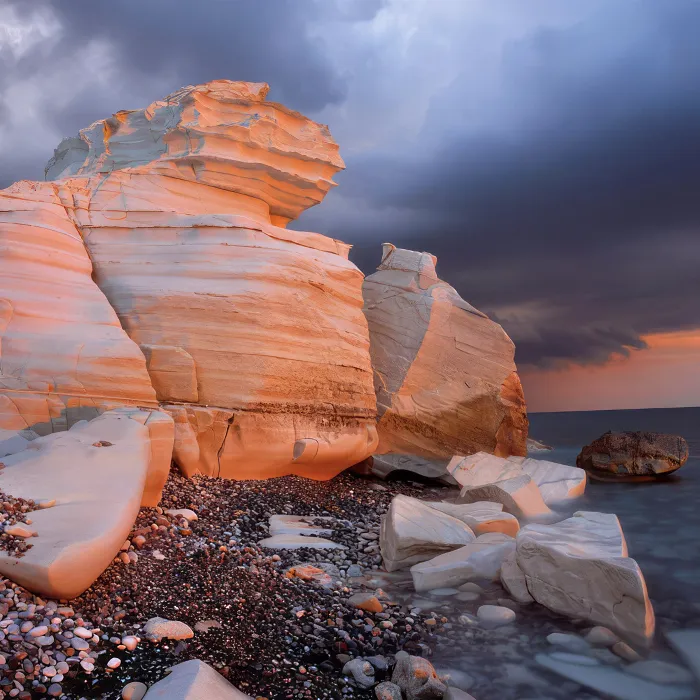Speaking of the golden ratio: if I had stuck exactly to the "classic" division (3:5) for this motif, the ridge in front of the mountaineer would be shorter and the "air" above the glacier smaller, meaning that the image would not be nearly as expressive. Technically, 1/125 of a second is enough to freeze the action. (For telephoto lenses from 135 mm without image stabilizer, 1/250 second is better). Seblaskogel, Stubai Alps, Austria.
However, classic is not necessarily the same as simple. Not only do we have to pay attention to technical aspects, we also have many different possibilities for interpretation. Action, i.e. freezing movement, always requires a fast shutter speed. But how fast is movement and what is a fast shutter speed? For two strolling walkers 50 meters away, 1/125 of a second is usually enough.
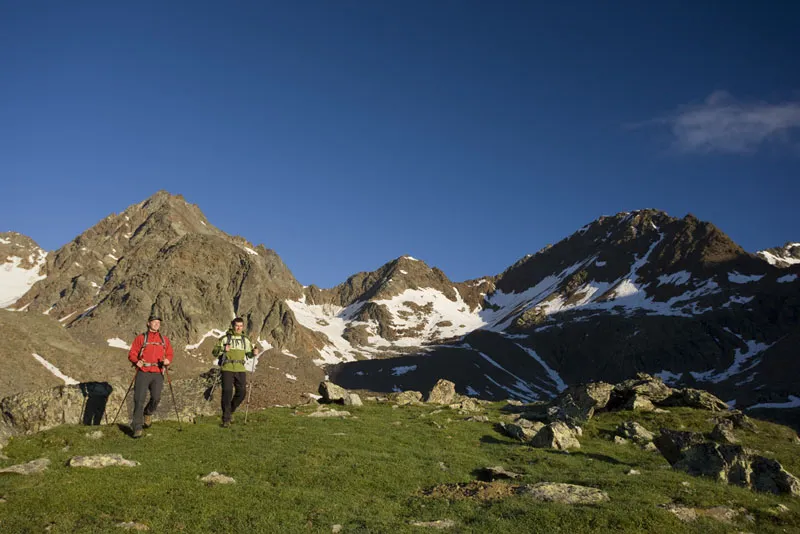
This imagery is currently in vogue: close-up, cropped, active. For fast steps, the shutter speed should be correspondingly fast. In this early morning shot, I "only" worked with 1/250 second at Blender 5 and ISO 640. Alpspitze, Wetterstein Mountains, Germany.
Another example: A freerider (as deep snow skiers are called nowadays) makes a long but fast turn (used to be called a turn) in a large mountain ridge. I have a slightly wide-angle lens on the camera to include the surrounding landscape. Is 1/250 of a second enough here? Well, maybe - but 1/500 of a second is better.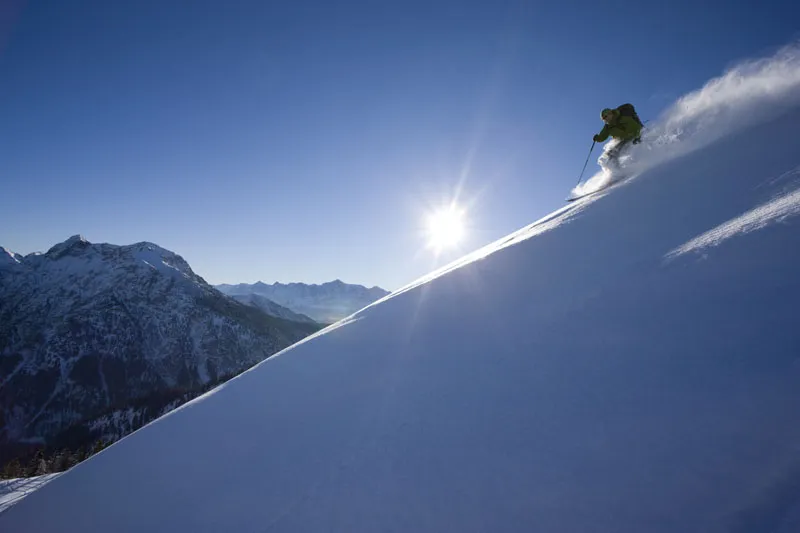
The skier was frozen by the short shutter speed of 1/800 second. Only the dusty snow expresses the actual fast movement. Ochsenalpesköpfle, Ammergau Alps, Austria.
A new scene a little later. This time I have the 15 mm super wide-angle lens on the camera. A very sporty, not to say aggressive skier comes towards me at almost 80 km/h!!! and passes me at a good meter distance. Dusting snow.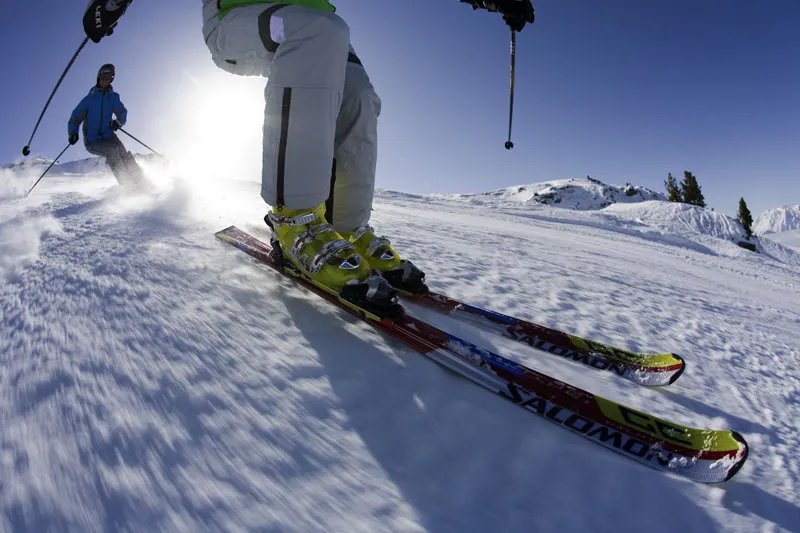
This picture is actually an overlap of two techniques. On the one hand, I froze the extremely close skier at 1/1000 of a second, and on the other hand, I followed him slightly to emphasize the extremely fast movement. Zillertal Arena, Zillertal Alps, Austria.
The 1/1000 second is the minimum here; whenever possible, I even try to get to 1/1500 or 1/2000 second in such situations by either changing the ISO sensitivity upwards (e.g. ISO 400) or opening the Blender.
Due to the extreme wide angle of only 15 mm (full-frame fisheye), the distances in this picture are deceptive. The driver, here frozen in focus with a shutter speed of 1/1250 second, passes me at a distance of just three meters. Hintertux, Zillertal Alps, Austria: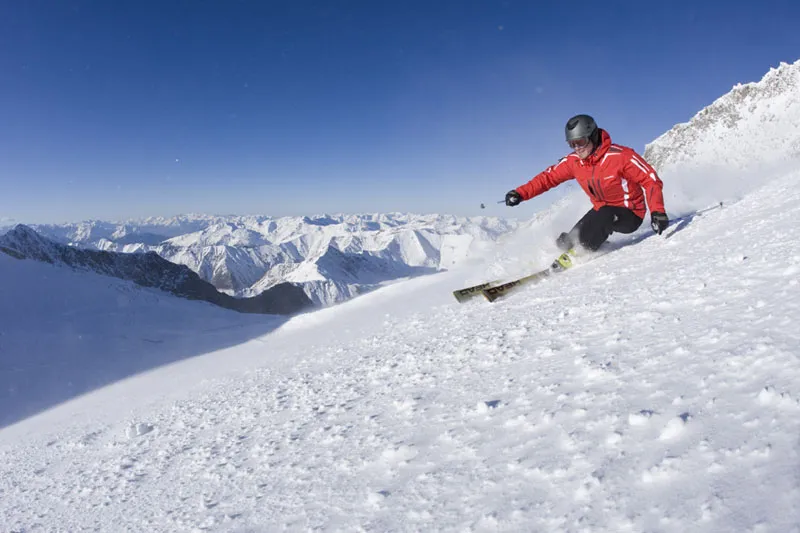
The same scene as before - only photographed at 1/800 of a second. The driver is slightly out of focus ... but the foreground and background are perfectly sharp.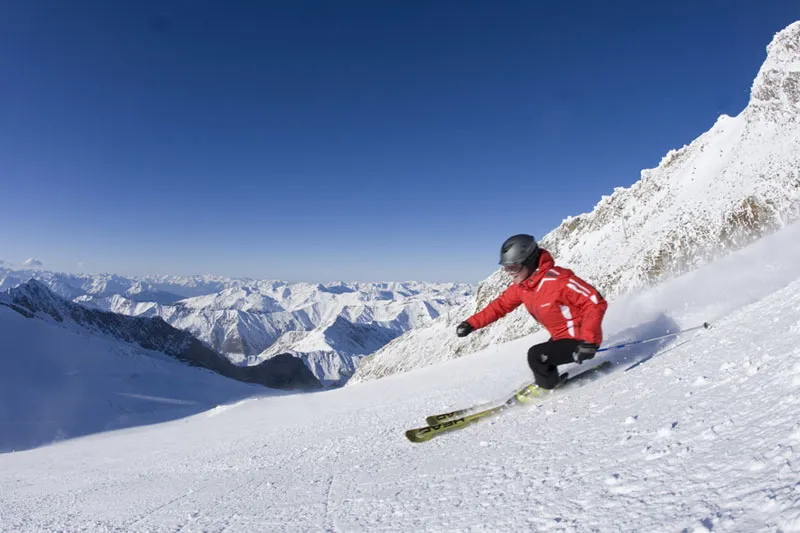
Basically, the following factors can be summarized in this area of photography: the faster the movement, the faster the shutter speed must be. However, it is not only the absolute speed of the movement that is decisive, but also the distance to the lens: the closer the subject is to the camera, the faster the shutter speed needs to be.
Which technique is recommended for this area of photography? I also (almost) always use aperture priority (aperture priority) in sports action photography. This means that I select the Blender and the camera controls the shutter speed after the exposure measurement. However, unlike in landscape photography, I now have to pay attention not only to the aperture and thus the depth of field, but also to the shutter speed. If in doubt, I prefer to forego some depth of field and open the Blender in favor of a faster shutter speed. Only if I'm photographing the same fast activity over a longer period of time, which always requires a certain shutter speed, do I switch to aperture priority mode (shutter speed preset) as an exception. Here you preselect the desired time and the camera calculates the correct Blender based on the current lighting situation. But very important: Please do not forget to return to the usual working mode!
Neither focusing nor depth of field are a problem with pictures of this type, regardless of whether you use autofocus or manual focus. At Blender 9, even the peaks in the background (despite a slight telephoto focal length) are still within the depth of field. Venter Höhenweg, Ötztal Alps, Austria.
Another important aspect is the focal plane in the picture. Regardless of whether we are photographing hikers or skiers, we want the subjects to be in focus. If we want to freeze the movement, the focus must be "on point". This is not a problem with the "hiker opposite". Regardless of whether you use autofocus or manual focus: there is enough time to focus on the people. If you then also close the aperture by two or three values, the focus should be right in any case. But there is an exception to every rule: does the focus always have to be on the subjects? Of course not, it can also be appealing to focus on the foreground and leave the actors slightly out of focus with a relatively open Blender.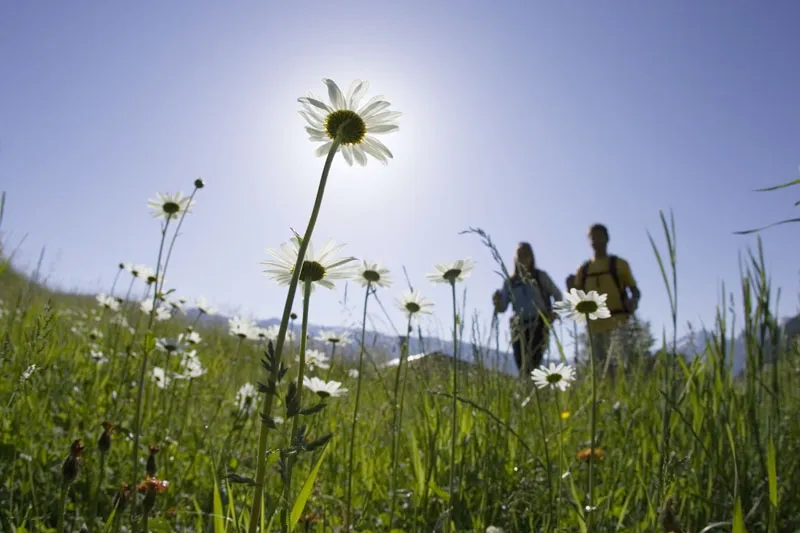
Photos of this kind provide variety. The hiking scene remains clearly recognizable, although the focus (at Blum 9) is clearly on the flowers. Zellberg, Zillertal Alps, Austria.
The close-up action is much more difficult. Neither the autofocus nor the photographer can guarantee a one hundred percent success rate in the close-up action range. What often leads to the goal here is a very banal trick, the so-called focus trap. Many people still know it from analog times without autofocus. Back then, I often focused manually on a stone, fence or similar. When the hikers were at the height of the pre-set focus, I released the shutter once with great concentration. Multiple shutter releases were usually impossible, as the manual cameras did not yet have a continuous shooting function and the film transport and winding of the shutter using the quick release lever not only took too long, but usually also changed the image composition.
In addition, the bulky, additional motor drive was too heavy for me. After seven attempts, I usually ended up with a sharp picture in which the position and posture of the people were correct. I still occasionally work according to this principle today, mainly in the sports action close-up sector. For example, I manually adjust the focus on the lens, preferably on the strong wide-angle lens, to one or two meters. At the decisive moment, I then release the shutter at maximum continuous shooting speed, regardless of whether I'm shooting a hiker, freerider or mountain biker.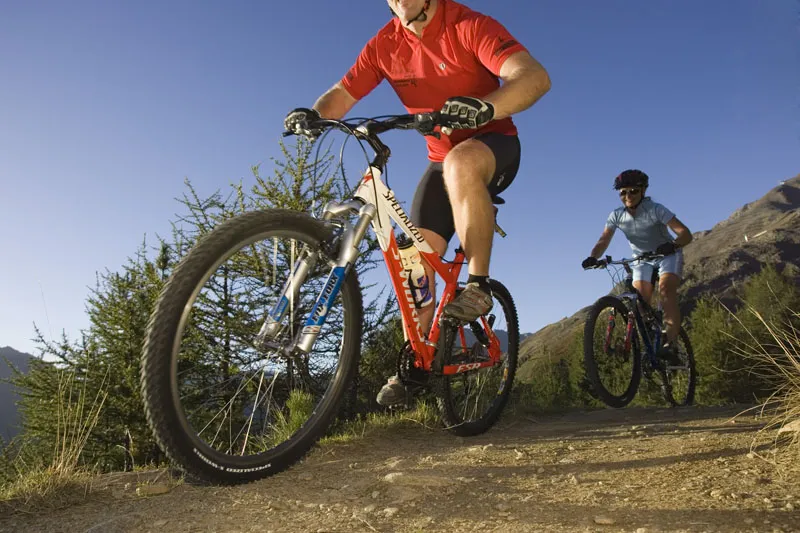
17 mm focal length, 1/1000 second and Blender 6.3 are the sober technical data for this shot. I had pre-focused to 1.5 meters. Hochsölden, Ötztal Alps, Austria.
Due to the large depth of field range of the super wide-angle lens, even at relatively open Blenders of 4 or 5.6, I achieve quite high hit rates with this method of working. But especially with ski photos, I realize every time how fast action can be. The time frame for a good picture is often just a fraction of a second. Suddenly the 10 frames per second of a Nikon D3 or Canon 1D Mark III don't seem so fast anymore. Of course, these two models, which are very popular with professional photographers, are prohibitively expensive for most amateurs. For sports photographers, they are neither a luxury nor a show-off, but a necessary standard. But now, finally, there are affordable alternatives for amateur photographers too. The Canon 50D or the Nikon D 300, with their approximately six images per second, offer an incredible amount for the money.
So apart from robustness, technical features and speed, what are the differences between a camera costing 1000 euros and a professional model costing 4000 euros? For example, in the number of possible RAW shots in succession without the camera requiring pauses for data transfer. The Canon 50D can take 16 pictures in a row, but the 1D Mark III can take 30!
Imagine the following situation: a long slope, 50 centimeters of fantastic fresh snow. The low winter sun models the slope wonderfully three-dimensionally out of its surroundings. The whole slope is still untracked. Three good skiers are standing at the top waiting for your hand signal. It starts, you release with the first turn, then the next ... Three seconds have already passed, 6.5 images per second are recorded. The camera is calculating, it can no longer be triggered. But only now does the perfect picture appear ... I don't think I need to go on.
If I had triggered the shutter at maximum continuous shooting speed from the first swing, I wouldn't have been able to take any more pictures at this point. But it is only at this point that the three riders are really well placed. However, the picture not only expresses the joy of deep snow skiing, but also the dangers of the high mountains due to the small avalanche in the shade. Madonna di Campiglio, Brenta, Italy.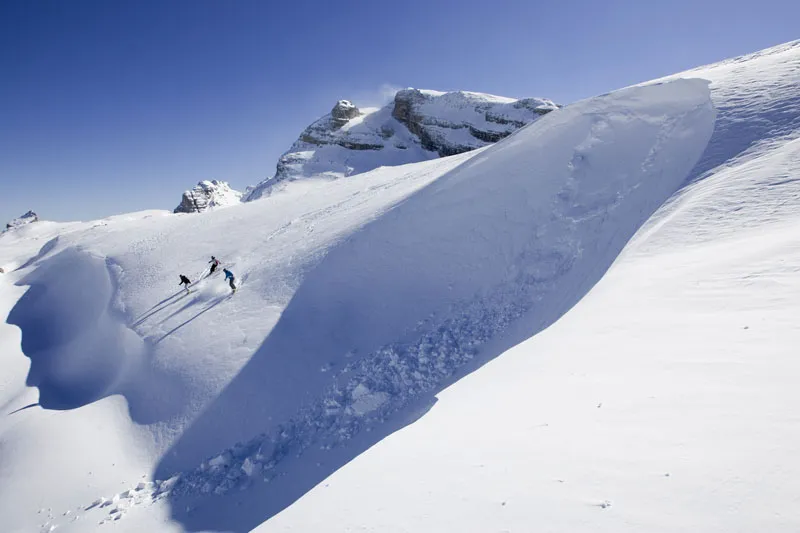
However, there are also tricks for such situations to make the best and most effective use of your own technical capabilities. Firstly, I play through the entire shooting situation in my mind beforehand. Where and when is it photogenic, where and when do I want to release the shutter. During the shoot, I consciously concentrate on the "beautiful" moments when looking through the viewfinder. Only then do I release the shutter and save my given volume for as long as possible. With a little practice, you can get a feel for the number of possible shots in fast action photography. Speaking of "beautiful" moments: photography is at least as often about finding the "right" moment.
I followed the climber for a good ten minutes with the EF 2.8 70-200 mm-L IS zoom lens, which together with the camera weighed a good 2.5 kilograms. At the decisive moment, all I had to do was release the shutter.
I didn't change the cropping of the picture (like all the other shots, by the way)!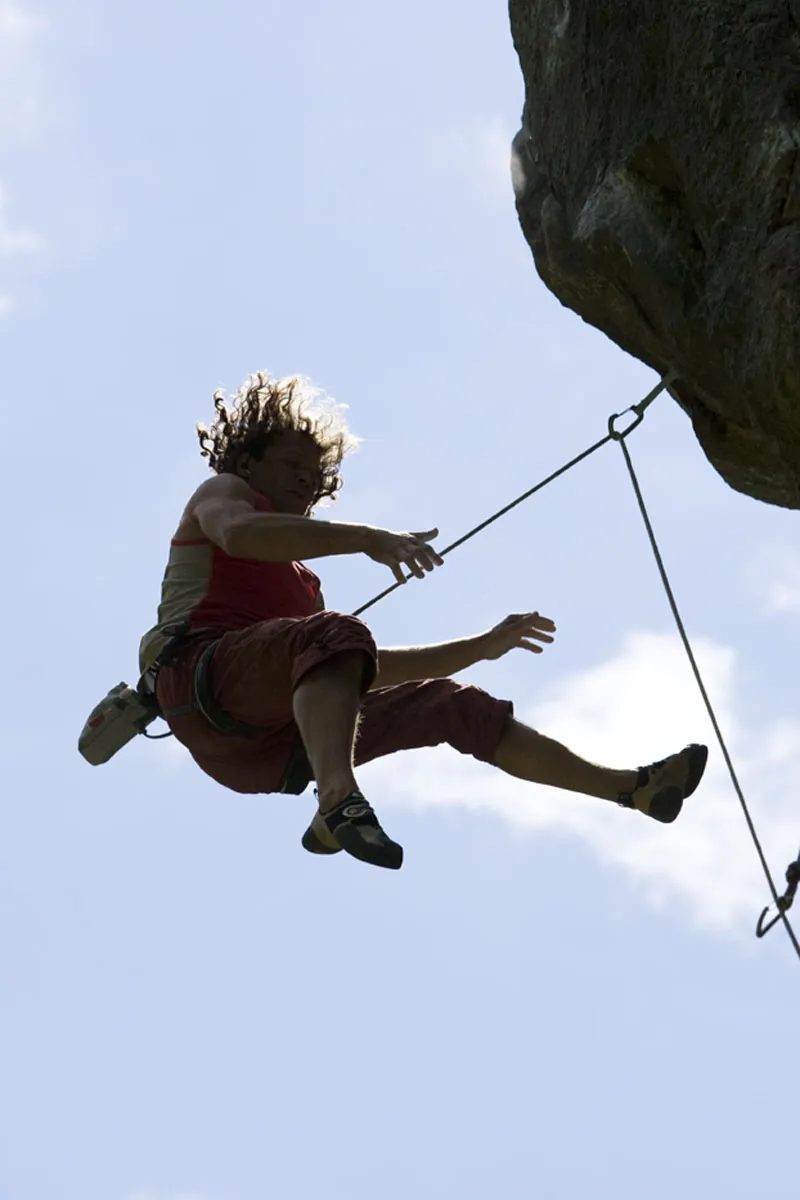
1/1600 second at Blender 6.3. Climbing area Ewige Jagdgründe, Zillertal Alps, Austria.
To catch the decisive moment, you often have to hold the camera in front of your eye for long periods of time and, if necessary, react at lightning speed. But this requires a lot of experience and, at least with long telephoto lenses, a lot of strength.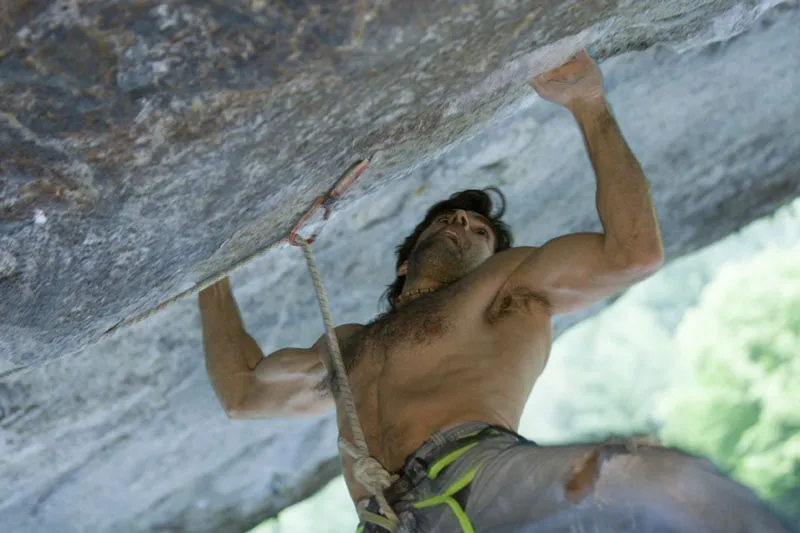
Thanks to the image stabilizer, I was able to take a blur-free photo at just 1/40 of a second. However, the (weak) use of a flash somewhat intensifies the sharp, frozen impression. Bachhexe, Zillertal Alps, Austria.
One last piece of well-intentioned advice: Even in times of cheap hard disks, I recommend rigorous sorting out at home on the computer. Compare the shots in a series critically and only archive the best images. Anything else will lead to data chaos. Lots of action fun...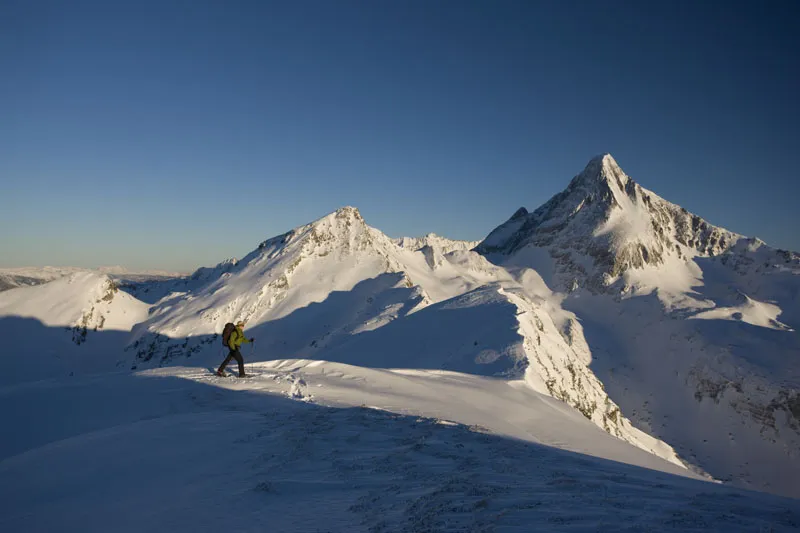
Finally, here's another classic for frozen motion with 1/200 second at aperture 8. Snowshoers on the Geißkopf, Zillertal Alps, Austria.
